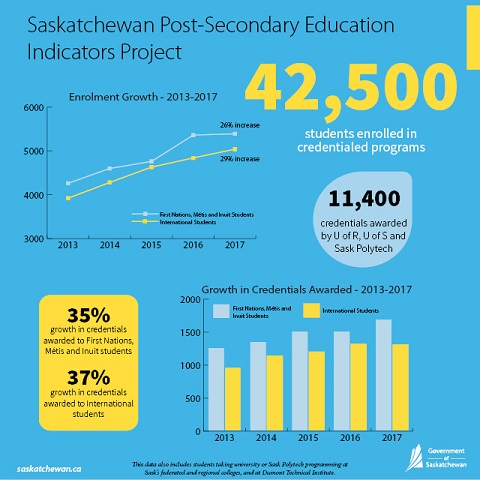Provincial post-secondary education report launched
For the first time ever, the province of Saskatchewan will release a report highlighting metrics, trends and data related to the province’s post-secondary education sector.
By Kris FosterThe U of S, as the largest higher education institute in the province, played a significant role—along with the University of Regina and Sask Polytech—in the pilot project to develop post-secondary indicators and resulting report, said Troy Harkot, director of institutional effectiveness in the office of Institutional Planning and Assessment.
“The idea to collaborate on common data, metrics and definitions was initiated by the Ministry of Advanced Education” said Harkot, who with two other U of S employees represented the U of S on the pan-provincial working group. “We’ve worked the last couple years to develop common metrics around enrolment, research and finances so that this information can be reported in various ways to the government’s stakeholders.”
With the Ministry of Advanced Education’s 2018-19 allocations to post-secondary education approaching $730 million, Harkot said it is important that the public—as well as other branches of government—receive accurate information on activities within the post-secondary sector. This was impetus for establishing the Saskatchewan Post-Secondary Education Indicators project and reports.
The first report resulting from this work was released at the end of May and is intended to provide insight into the higher education landscape in Saskatchewan, said John Rigby, interim associate provost of Institutional Planning and Assessment, and member of the steering committee that led this work.
“It was the aim of the steering committee to oversee the development of a series of metrics that will improve the understanding of the post-secondary education sector and increase awareness of the activity that goes on in this area,” explained Rigby. “Taken in whole, it sheds light on trends and activities of a very complex sector that has far-reaching benefit for the province and its people.”

One trend Harkot pointed to is the combined overall enrolment growth at the University of Regina, Saskatchewan Polytechnic and University of Saskatchewan, with student headcount increasing by an average of 1.9 per cent annually over the past five years to 42,500 total students in fall 2017.
Additionally, the demographic details of the student body at the three institutions has revealed that the number of First Nation, Métis and Inuit students has grown by 26 per cent since 2013, totaling, 5,390 students in fall 2017, and international student enrolment, during the same timeframe, has grown by 29 per cent to 5,040 students in fall 2017.
The initial report is very centred on students as the government and all participating institutions share “a common interest in student support, engagement and success,” Harkot said. “The ministry is very interested in understanding the student experience, are they engaged, do they get a quality education and do they get jobs after graduating. These questions matter to all of us.”
Other areas that are being tracked and will eventually be reported on include research revenue and outcomes, financial information such as revenues and expenditures, and employment rates two years after graduation.
Harkot said the U of S, because of its U15 membership and participation in that organization’s data exchange program, has been involved in processes for tracking and reporting on common data and metrics since 2011.

“Because of our membership in the U15 we have been able to share best practices with the working group and provide options for how this project could unfold,” Harkot said.
Overall, Harkot said he has enjoyed the process and working with other provincial post-secondary institutions.
“It wasn’t straight forward to identify common metrics and definitions, but the outcomes have been positive so far,” Harkot said. “Effective collaboration and partnerships with the Ministry of Advanced Education, University of Regina and Saskatchewan Polytechnic made this a strong project. It resulted in some really solid information, and that knowledge will prove to be very useful. It was a great opportunity to get together and collaborate towards something very positive.”
Harkot said it is anticipated that future reports will be released with additional metrics and will eventually include all post-secondary education institutions in Saskatchewan, including regional colleges and technical institutes.

